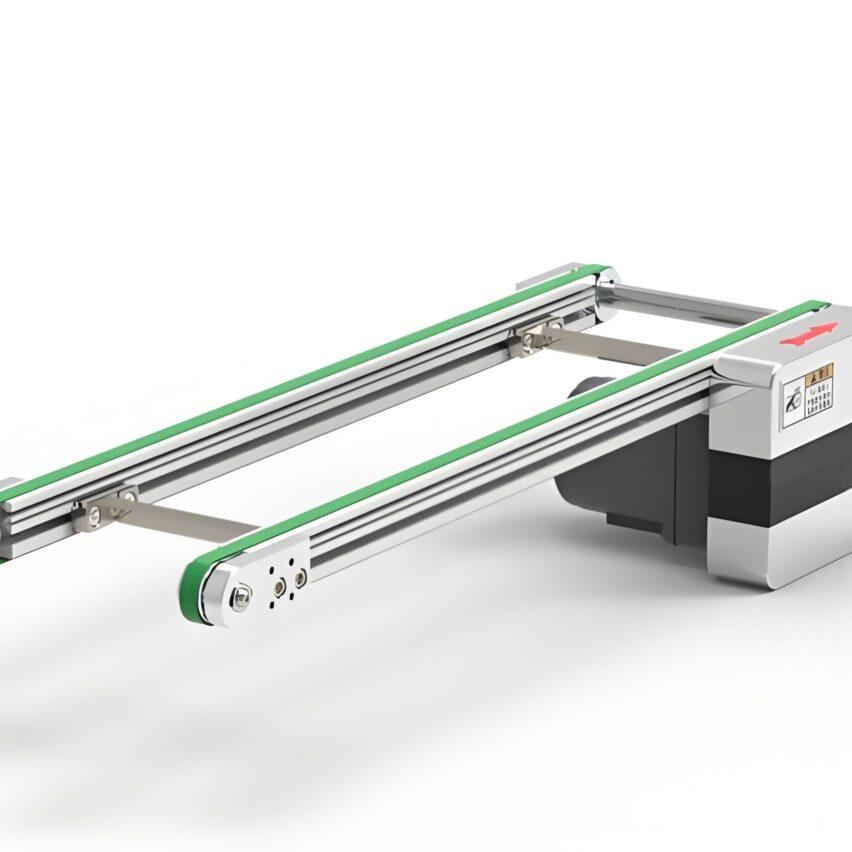I. Technological Reconfiguration: From Mechanical Transmission to Intelligent Controls
The essence of a pallet conveyor isTranslating Newtonian mechanics into programmable logistics algorithms. While conventional conveying relies on fixed rails, modern systems work byIntegration of modular mechanical units with data neural networks, breaking through three major technical bottlenecks:
- Dynamic Adaptation Architecture: Aluminium profile guide rails with integrated spring limiters, resulting in a 60% reduction in cargo deflection rate and a 26% increase in yield rate for heavy-duty scenarios;
- Space folding technologyThe double line body design of the speed chain compresses the area of 40%, and the AGV intelligent return system improves the efficiency of pallet circulation by 50%;
- Extreme condition breakthroughMilitary-grade plastic components in -25 ℃ ~ 120 ℃ environmental deformation rate <0.1mm / m, salt spray test life of more than 100,000 hours.
"Modularity is an engineering solution to the laws of physics."-This concept drives the realisation of conveyor systemsElastic extension of mechanical properties, establishing a dynamic balance between rigidity and flexibility.
II. Systematic evolution: four types of modes of technological gaming
1. Conveyor models: balancing rigidity and efficiency
- Roller/chain conveyors enable continuous transport with zero interruption in the loading process and a cache capacity increase of 40%;
- However, the path change requires reconfiguration of the hardware, the combination of devices occupies too large an area, and the lack of flexibility becomes the core pain point.
2. The shuttle revolution: a semi-flexible breakthrough
- Reciprocating shuttle to achieve lateral conveyance of the roadway, equipment reduction of 50%, but a single point of failure can lead to system paralysis;
- Ring Shuttle Upgrade: A 3x increase in multi-vehicle synergy capacity with a 70% increase in track complexity.
3. The AGV model: the ultimate in data-driven flexibility
- Laser guided vehicle realises intelligent switching of paths, process adjustment only requires program update, and investment protection rate is increased by 60%;
- Tesla Super Factory Application Case: Thousands of AGVs collaborate to handle more than 1,000 pallets per hour, and vehicle offline time is compressed by 35%.
4. Disc conveyor: the king of high-temperature scenarios
- The whole plate stamping pallet is resistant to 700℃ high temperature, 30°inclination transport breaks the limitation of belt machine;
- Multi-point unloading + fully enclosed design, dust spillage rate to zero, accident rate in the chemical field down 90%.
III. Vertical battlegrounds: from automotive manufacturing to the carbon efficiency revolution
Automotive Industry Scene
- Highly accurate magnetic scale positioning (±0.05mm) keeps component assembly error rate down to 0.03%;
- Volkswagen production line practice: modular guide reduces changeover time to 1/3 of traditional, space utilisation up to 90%.
E-commerce logistics disruption
- Amazon Smart Warehouse: ring shuttle + AGV hybrid system, processing over 100,000 orders per day;
- Bamboo fibre chain link plate carbon footprint down 60%, Shanghai Hub saves 2.3 million yuan in annual electricity costs.
New rules for the carbon efficiency game
| shore | Technical Advantage | Chinese countermeasure strategy |
|---|---|---|
| EU | CE marking system | Graphene Noise Reduction 15dB Technology |
| Japanese | Silent Technology | Magnetic scale ±0.05mm positioning |
| North America | Revolving lease network | SaaS Platform + Sharing Economy Model |
When bamboo fibre chain plates flow around the clock in the cold chain network, these innovations are in fact the resistance of industrial civilisation to the law of entropy increase. PwC forecast: modular delivery ecosystem to spawn in 2027180bn carbon market.
Self-questioning: penetrating the industrial fog
Q1: How can SMEs break through the European and American technology blockade?
A: Vertical patent jam + micro-innovation combination punch
- Anti-Offset Tooling Plate: Field structure + edge computing chip, heavy load scenario incident response up to seconds;
- Short Distance Conveyor LineCompatible with 380-580mm pallet sizes, 12ppm efficiency to corner the market segment -Building Asymmetric Advantage in the Giant Standards Gap.
Q2: How do companies balance the cost of retrofitting with intelligence?
A: LaaS model + capillary level innovation
- Beverage giant practice: core line with temperature control ± 0.1 ℃ system, auxiliary line for bamboo fibre board cost reduction 60%;
- Old thread regenerationThe modular rail is added to the production line of the ground drag chain, and only 15% of the new line is invested, but the space conflict of 50% is solved.
Q3: What is the value anchor for the industry in 2030?
A: Moving from "tonne-kilometre cost" to "carbon efficiency freedom"
- Energy consumption ratio of 0.8kW/ton-km (optimised by 1,70% compared to 2019) and fixed asset investment in the LaaS model down by 37%;
- the ultimate prophecy:.Dual algorithms for mechanics and carbon efficiencyThe dominant player will monopolise the 60% high-end market, and China's graphene technology patent growth rate reaches 17%.
Exclusive Data Insight::
The global pallet conveyor market size is set to cross USD 7.6 billion by 2027, and theThe real competitiveness of Chinese companies is not in the sales of AGVs (accounting for 60% globally), but whether they lead the international standard of "carbon efficiency algorithm".. Currently Europe holds the 45% core patent, but China has differentiated itself in areas such as multiplier chain bilinear bodies (static stiffness increase of 70%) and bamboo fibre materials (carbon footprint reduction of 60%)-The next round of the game will be won or lost by whoever can translate Newton's third law into a tradable formula for reducing carbon emissions..













